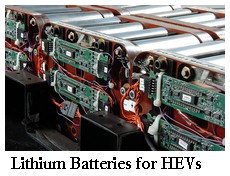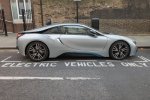Electric Car Batteries: Lithium!
You've probably heard that all the new electric car batteries coming out in the cars from the major automakers are lithium ion batteries, right? So you might ask, what's the difference between lithium ion and, say, lithium iron phosphate (LiFePO4)?
Lithium iron phosphate (LiFePO4), the EV conversion crowd's lithium battery, is actually a lithium ion battery, too.
It just comes in three basic shapes:
- prismatic (Sinopoly, CALB, Fluxpower/Voltronix, Realforce, etc.);
- cylindrical (A123, Headway); and
- pouch (usually lithium polymer but A123 has some LiFePO4 in this form, as do a few others).
Lithium iron phosphate (LiFePO4) is a slightly tamer form of lithium ion battery than you find in your laptop, but it will still take you 100 miles on a single charge.
So I got a chance to talk with Mike Collier at Lithium Storage about lithium electric car batteries. He sells prismatic LiFePO4 battery packs for EV conversions, and I've found him to be quite knowledgeable about lithium electric car batteries in general. I also spoke with Jack Rickard from EVTV, who has done several AC electric car conversions using different brands of LiFePO4 cells, and he's put the LiFePO4 cells in both AC and DC systems.
Lithium Ion Batteries: Pouch Cells
Mike Collier from Lithium Storage says:
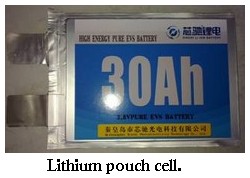
Pouch cells have the benefit of being thin and easy to build into large "proprietary packs". And some have a bit higher energy density. But these pouch cells are more expensive and require greater attention to temperature.
For another example, Kokam cells (lithium polymer) come with very elaborate heating and cooling systems.
Pouch batteries also expand when they are charged and discharged, so they have to be contained.
LiFePO4 Electric Car Batteries
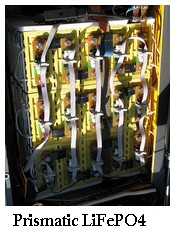
For electric car conversions there's just nothing better than the LiFePO4 electric car batteries right now, and the most readily available ones are the Chinese prismatic cells. 100 miles on a charge is NORMAL with these. The price is reasonable. They're safe and reliable. And they're available to ship anywhere here in the US.
Conversation with Mike at Lithium Storage
Lynne: I see that the Chinese prismatic cells are identifiable by their colors, like sweetener packets at the coffee bar! Yellow? Blue? (Pink, anyone?) Does each company stick with just one color?
Mike: The color thing is complicated. Here we go:
- Fluxpower/Voltronix cells come in Green and Yellow.
- CALB (formerly Skyenergy) cells come in either Blue or Gray.
- Thundersky cells USED TO come in Yellow (but Thundersky is now bust).
- Winston Battery cells come in Yellow.
- Sinopoly cells come in either Yellow, Green or Black.
- Realforce cells come in either Black or White.
- GBS cells can be found in either Yellow or a Blue-ish hue.
- Hipower cells come in White.
And yeah, I'm sure I could get you pink batteries if you wanted.
What would you say are the major distinctions with each type? Seriously, they all seem about the same to me. I can't make heads or tails out of the subtleties of the graph curves.
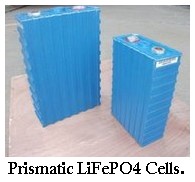
Is there a difference? Well, Skyenergy, GBS and Sinopoly were among the many manufacturing partners under old Thundersky. So the appearance, construction and chemistry were nearly identical. These three have all branched out on their own and now things are slightly different. I'm not familiar enough with GBS to make any claims regarding their chemistry, but the case design has changed to incorporate a neat cap and awkward busbar system.
Skyenergy is now CALB. Their cells can be found in identical sizes to Thundersky, but colored blue. Inside, the CALB cell has a slightly different voltage range, a higher C rating and lower failure rate. Sinopoly cells match the old Thundersky, but new cells are a bit smaller in physical size.
I should note that Thundersky still offers cells, but the data sheets indicate a higher top voltage than I'm comfortable with and the charge cycle life is falsely stated.
Thanks, Mike.
And now back to Jack Rickard from EVTV:
Jack: We use Thundersky (yellow) or CALB (blue) batteries somewhat indiscriminately. Both are excellent LiFePo4 cells. We've had great luck with them. In the case of the Mini Cooper Clubman, we use smaller 100Ah cells and 112 of them to get that 375 volts. In the lower voltage cars, we use LARGER cells of 180 Ah.
Lynne: So they both work fine, they cost about the same, it's mostly a matter of what fits in your available space and battery boxes, right?
Jack: You got it.
What's Good About Lithium Electric Car Batteries?
- Lithium lasts longer.
A lithium pack will last you something like 10-12 years. This brings the price down to the point where it costs the same as, or even less than, a comparable lead acid battery pack. - Lithium is lighter.
A 144 volt system with 200 AH (that's quite peppy and will take you a long way between charges) will have around 720 lbs worth of lithium batteries. Compared with 1500 lbs or so of lead.
- Lithium mining is environmentally gentle and human friendly.
I listened to this NPR special on electric cars the other day, which is kind of long, but has a really interesting discussion of the process of lithium "mining". It is not mined at all, but rather comes naturally in a salt form that is found out in the open in South America (The "Salar" in Bolivia), sun-dried by locals, and trucked to its destination. No miners trapped underground, no fracking, no toxic waste. - Lithium likes speed.
Freeway driving won't intimidate your lithium electric car batteries; no matter what kind of motor you've got in your electric car, lithium will keep bringing the amps. They're pretty tolerant of rapid charging and discharging. The "lead foot tax" is less of an issue. - LiFePO4 is safer lithium.
If you've seen the flaming laptop YouTube videos, you'll appreciate another set of YouTube videos where someone's pounding a nail into a LiFePO4 battery and nothing happens. Nice. - LiFePO4 is tolerant of deeper discharge.
This might be one of the best qualities of lithium.
Mike says: "Another benefit to switching from lead to lithium - aside from weight loss - is the DOD (depth of discharge) that lithium batteries will tolerate. Lead batteries shouldn't be taken below 50% DOD. So lithium not only has a higher energy density, but it has a deeper use of stored energy. Basically AH to AH, lithium will always provide more useable energy than lead."
What's Not So Good About Lithium Electric Car Batteries?
Reputable LiFePO4 Battery Sellers
Mike told me a little about how to tell a reputable LiFePO4 EV battery distributor from...the other kind.
Briefly, a reputable distributor:
- Accepts credit cards;
- Has a good reputation in public forums;
- Responds to your inquiries in 24/48 hours;
- Communicates openly about what they do and do not have in stock and how long it will take to get what you order.
- More expensive initially.
...but it balances out in the long run, because LiFePO4 electric car batteries last longer. - Reputation.
Some of the Chinese prismatic cells have gotten sort of a reputation for being unreliable - but those are no longer in production. And some US dealers have gotten a reputation for being fly-by-night.
Lithium Storage has been around a while, has a good reputation, the batteries come with a two year warranty, and I trust them. - It takes a while.
You have to order your batteries, pay your money, and wait. If a shipment is coming from China, it can take 6-8 weeks to deliver. If shipped from USA inventory, it should only take five business days at most to ready a shipment for delivery. - Note on the battery warranty from Lithium Storage: A lithium pack is warranted to last 2000 cycles at 80% DOD (Depth of Discharge) = 6 years if fully discharged and charge every day. And 3000 cycles at 70% DOD. Most folks will not be fully reach 80% every day, many not even 70%. In those cases the life could reach the 10+ year mark.
Battery Management and LiFePO4
Mike and I talked a little about battery management systems and the need - or lack of it - for management. Turns out I was all wrong about WHY lithium batteries need to be managed.
Lynne: I heard that lithium ion batteries need battery management systems because lithium is prone to thermal runaway. True?
Mike: Thermal runaway is not much of an issue for the Chinese Prismatic or cylindrical cells.
The reasons for management are warranty validation, and to keep the cells within the required optimum voltage range. The BMS (Battery Management System) serves primarily to monitor cells and send alerts (this could be via screen or buzzer or dash light or relay power cutoff, etc.). Think of it as cheap insurance for the expensive battery pack. Otherwise cell/s could overcharge and suffer reduced life over discharge and prematurely fail.
Some folks are just fine without a BMS. But you have to religiously monitor the pack.
But lithium is sensitive to heat and cold, right?
Actually, lead batteries are far more sensitive to temperature than lithium, though lithium cells don't like to charge below 32 deg F. - the lithium just plates the other side and reduces the life of the cell.
Get LiFePO4 Batteries For Your Electric Car
If you'd like a set of LiFePO4 electric car batteries, you can reach Mike here at the Lithium Storage website.
